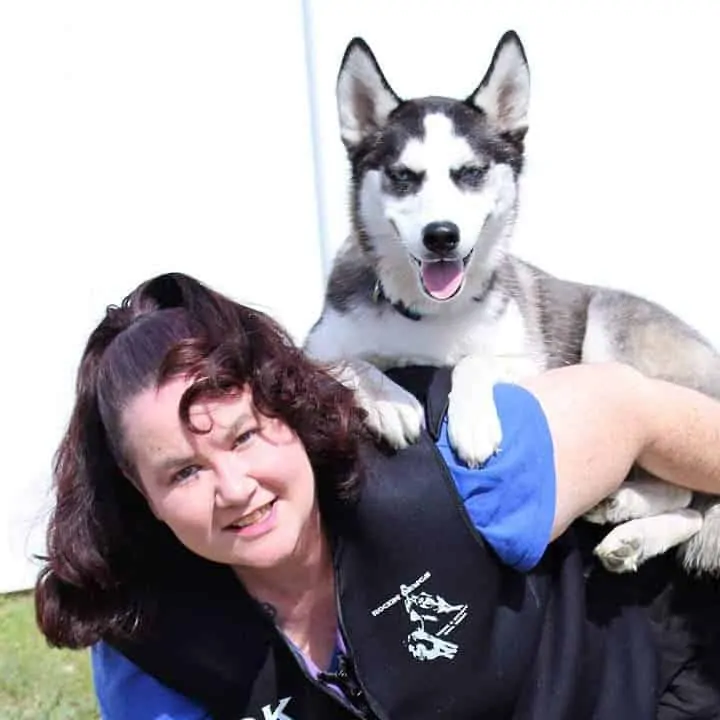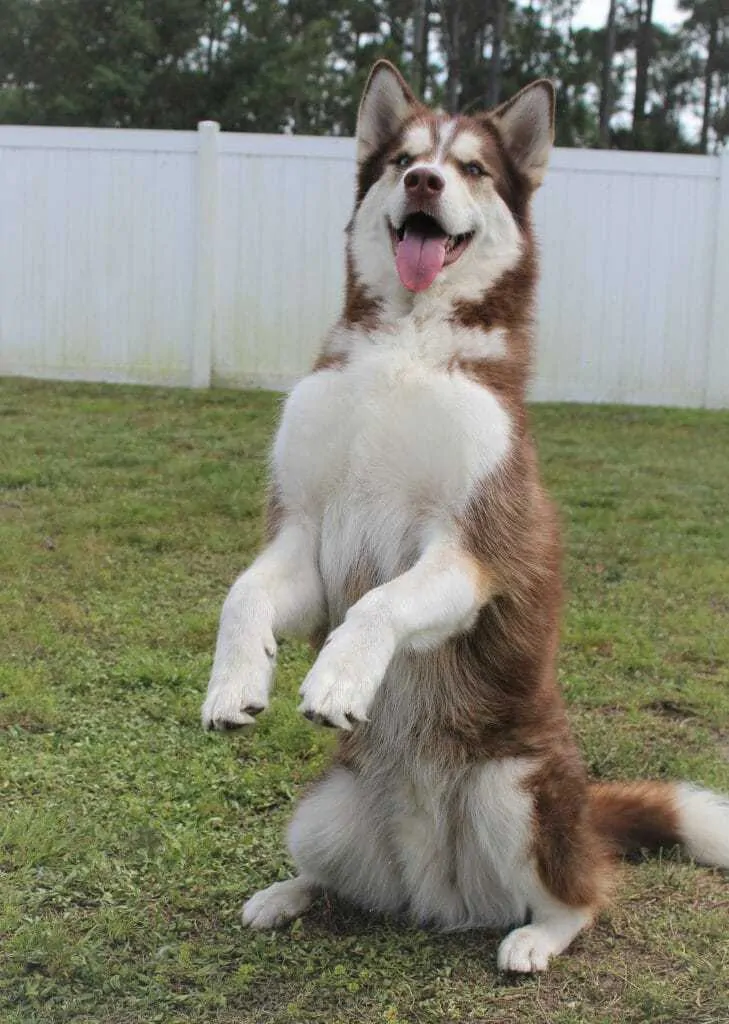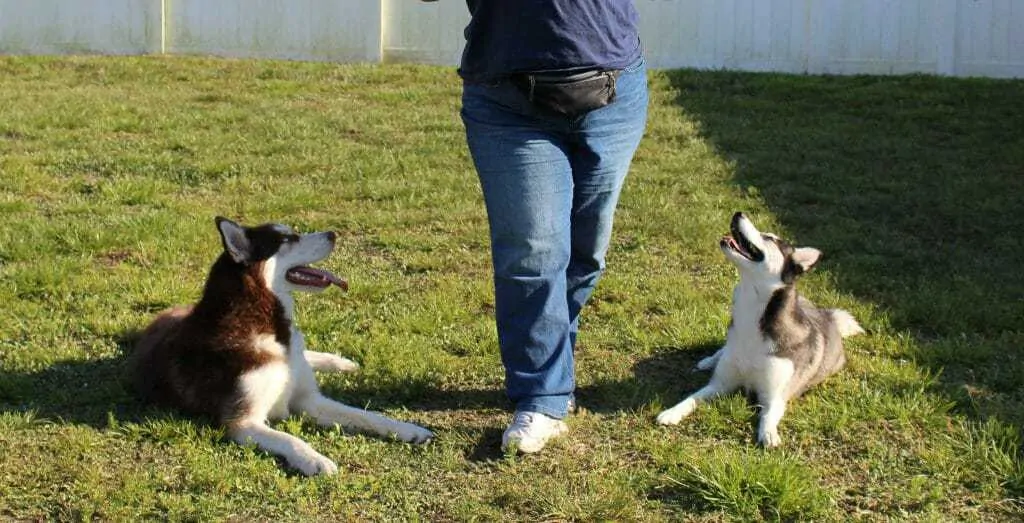In dog training, there are many ways to teach a new behavior. Luring, capturing, molding, mimicry and yes of course, shaping. So what is shaping? How does it benefit us in training and how do we apply it? Hopefully, I can answer some of those questions for you today so you can start teaching your own dog by using this skill.
This dog was taught to “Sit Pretty” by using the shaping technique of training.
Contents
What is Shaping?
Shaping is a way of breaking down a behavior in small, easy steps, capturing those steps and reinforcing them and gradually increasing your criteria, until you achieve the final desired behavior. This helps your dog understand that they are going in the right direction every step of the way and allows them to think about the decision processes it takes to earn those rewards. Think of it like the Hot & Cold Game we used to play when we were kids. The reinforcing sound of the clicker (you will learn about the clicker in the Tools of Shaping section of this article) tells the dog they are getting hot, while the absence of that marker tells the dog they are getting cold.
What Are the Benefits of Shaping?
There are many wonderful benefits of learning how to shape behaviors with your dog. Here are just a few:
- It can allow you to help your dog understand a behavior much more quickly than some other methods.
- It helps you break down teaching behaviors that your dog might find mentally or physically challenging.
- It can allow you to fine-tune a behavior your dog already knows, or teach more complex behaviors quicker.
Seppala learned how to do this complex behavior of pushing the lawn mower by chaining two cues of putting his paws up and walking forward, all accomplished through shaping.
- It can help you as a trainer, become much more effective in your timing and better aware of your dog’s body language.
This owner took the time to shape the process of putting on a muzzle. By doing so, they are able to read the dog’s body language and tell that they are comfortable wearing this new clothing.
- And best of all, it is essentially teaching your dog how to learn! Not only will it help your dog gain confidence, it will enable your dog to begin to use decisions in their training, which will translate over to quicker learning patterns for future things you might start teaching them.
Tools to Start Shaping
You don’t need much to get started training your dog, but a couple things could help you be a little better prepared when you start the shaping process.
- Small, tasty treats or food.
Since you will be rewarding lots of small steps towards a larger goal, you are going to need some pretty small treats or food that your dog is willing to work for. Try to keep them pea size or smaller. Some of my favorite go-to’s are air dried dog food such as Ziwi Peaks, meat cut up into tiny pieces or using your dog’s food bowl rations as training time instead of just letting them free feed from the bowl.
- A Clicker
Button clickers like this are my favorite to use, especially if you are new to clicker training.
While it is also acceptable to get your dog used to a verbal marker such as “Yes”, I find with shaping, a clicker really helps your accuracy in correctly marking the behavior you want. Timing and consistency are extremely important when learning how to practice this.
Before you start, familiarize yourself with how to appropriately use the clicker and “load” or “charge” it with your dog so he knows how to respond to this as a training tool. Check out this great article on “Clicker Training 101” to help you on your way.
- A Game Plan
Before you start clicking away and handing out those treats, make sure you know ahead of time exactly what type of steps you want to reward when you are trying to teach your dog a new skill. A lot of trainers jot down a little step-by-step plan to help them map things out on paper first. I find this to be extremely helpful, especially when you are working on a complex behavior.
How You Can Use Shaping In a Variety of Circumstances
Whether you are trying to teach your dog a basic obedience skill, working on fine-tuning a behavior your dog already knows, or want to teach your dog some amazing, complex tricks, shaping behaviors can be used across the board.
In Stunt Dog Trials, your dog must do a variety of tricks for an audience to earn the different levels of titles. Many of the skills taught, especially at the higher levels, are done with shaping.
It is also used to teach a variety of skills and movements in all types of dog sport disciplines and is commonly used when working with service dogs to help teach them some of the invaluable behaviors they will use to aid their owners.
The following are some examples of how you might use shaping to help teach your dog.
Shaping For a Basic Obedience Skill: Down Position
These dogs learned how to lay down using shaping methods.
The “Down” cue is a pretty submissive position and some dogs just aren’t that comfortable when learning it at first. Here is an example of how you can use basic shaping to teach a dog that might be mentally or physically challenged when learning this cue.
- Ask your dog to sit on a comfortable surface, such as a dog bed. Click & Treat (C/T)
- Hold a treat just below your dog’s nose. When he looks down, C/T. Practice several times until your dog is consistently looking down.
- Now, increase your criteria. Your dog must bend a little lower with his body, not just his head, before you C/T. Practice until confident.
- Increase your criteria again. Your dog must go a little lower at each stage in the process until you achieve the final result of your dog being flat on the ground.
Shaping to Fine-Tune a Behavior: Holding An Object for Longer Duration
Teaching your dog to “Hold” items can make for some cute photo ops!
Whether you are working on that perfect dumbbell hold in competitive obedience or just want to take the most adorable photo of your dog holding a rose in his mouth, you will need to work on building some duration on this skill.
- Hold out the item you want to teach your dog to hold. Any interaction can get a Click & Treat in the beginning (a look, a nose bump, a lick… anything!) This first interaction will be different for every dog. This is why having a game plan is a good idea.
- Here is a rough plan of how you might progress to getting your dog to hold the item longer. Remember, you will be clicking and rewarding at least several times at each stage before increasing your criteria and holding out for the next step. Of course, if your dog has a breakthrough moment and jumps ahead several steps, go with it and refer to your game plan to pick up at the next logical step.
Example Progression:
- Looks at item,
- Sniffs or nose bumps item,
- Opens mouth on item,
- Grabs or bites on item,
- Grabs item and holds for 1 second before dropping,
- Grabs item and holds for 2 seconds before dropping,
- Grabs item and holds for 3 seconds before dropping, etc.
Of course, your game plan is your own, so if you want or need to break down this sample into even more specific or smaller steps you can. That’s the beauty of shaping.
Shaping to Teach Tricks: Spin
Rocket is learning how to “Spin” circles. Here he is being rewarded at the ½ turn.
This technique is a great way to teach basic tricks or learn how to chain skills together to make a more complex trick. For this example, we are going to shape our dog to spin in a circle.
Let’s say you have a dog that sits down when you try to get them to perform a complete circle or maybe is uncomfortable bending in one direction. Shaping would be a really effective way to teach this trick.
Seppala’s spins were taught with shaping. Once he learned the trick then we thought of creative ways to make them more complex and creative. (self-taken)
Just follow this basic break down:
Stand up and hold a treat nose level to your dog right at your core. Take the treat slightly to one side of your dog that you want him to turn in the direction of.
Reward step for:
- Dog turns head in that direction (Click & Treat)
- Dog takes 1 step in that direction (C/T)
- ¼ turn (C/T)
- ½ turn (C/T)
- ¾ turn (C/T)
- Finished Spin!
What is Free-Shaping?
A dog and a box…what kind of tricks can we possibly teach using free-shaping? There are so many!
Now that you can see how you can use shaping to teach a variety of skills, I must introduce you to the process of free-shaping. Free-shaping is considered an advanced training technique, and is really shaping in its purest form. In some of the earlier examples, we kind of helped our dog by starting with a lure to set them in a general direction. With free-shaping, any random behavior your dog offers that might relate to what you are trying to teach should be marked and rewarded at first. Your dog is making all the initial moves and decisions, without any prompting or luring.
Once your dog is easily offering a variety of behaviors, you can start picking and choosing which ones you want to move forward with, and develop a plan again as you did when you were teaching the basic shaping technique. By doing this you are allowing your dog to really make his own decisions about the entire training process, making it not only a more enjoyable training session for your dog but it can also really help a shy or fearful dog begin the process of offering behaviors, instead of shutting down during attempted training sessions.
Free-Shaping Practice: 101 Things to Do with a Box
To help you better understand this process, I invite you to try my most favorite game in learning this skill. It is called “101 Things to Do with a Box” and it was first introduced by the amazing trainer, Karen Pryor, who originally derived the game from a dolphin research project she was a part of during her marine mammal training days.
Here is a brief video to help you see the steps you will take in free-shaping with this game.
This video shows a beginner dog in the initial practice sessions with the “101 Things to Do with a Box” game. It is amazing to see how many behaviors the dog offers.
A few ideas of what you might teach your dog to do with a box:
- Carry the box
- Sit in the box
- Circle the box
- Flip the box
- Push the box across the room with his nose
- Paws up on the side of the bx
Now go give it a try! What can you teach your dog to do with a box, simply by rewarding the steps they take in the right direction?
Have fun learning this new skill everyone! You are well on your way to becoming a more effective and knowledgeable dog trainer 🙂

Kim Mayes has been training, performing and competing with her dogs for over 20 years. She is a Certified Professional Dog Trainer (CPDT-KA) a Certified Trick Dog Instructor (CTDI) and Stunt Dog Judge (SDJ) amongst her many certifications. She is a published author in the area of training and behavior, writing books such as “Getting Braver” and “Hyper Dog 101” and owns Rockin’ Dawgs Positive Dog Training LLC in Rockledge, FL. She is also a proud member of the Pet Professional Guild which promotes the importance of using force-free training.
Kim resides in Brevard County, Florida with her 3 Siberian Huskies, Seppala, Rocket and SuperNova, and her Chinese Crested Dog, Loki. Her wonderful rescue pack has gone on to achieve Champion titles and even hold world records in the trick and stunt world.









